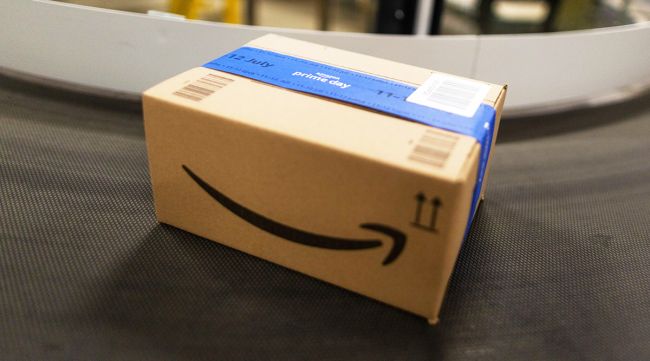Thousands of third-party sellers who ship products themselves will start paying a 2% fee on each sale in October. (Chris Ratcliffe/Bloomberg News)
Amazon.com Inc. is imposing a new fee on merchants who don’t use the company’s logistics services, a change many of these sellers consider coercive and surprising since the U.S. government is poised to file an antitrust lawsuit against the e-commerce giant.
Thousands of third-party sellers who ship products themselves will start paying a 2% fee on each sale in October, according to documents reviewed by Bloomberg. That’s on top of the commission — usually 15% — that merchants already pay Amazon to sell products on the popular web store.
Several merchants interviewed by Bloomberg interpreted the new fee as an attempt to pressure them into using Amazon’s logistics services rather than fulfilling orders themselves. The company didn’t explain to sellers why the levy was required, but told Bloomberg it will help cover the costs of running a separate infrastructure and measuring its effectiveness.
Amazon has been accused of having too much power over the some 2 million merchants who use its platform, which captures about 37.6% of all online spending in the U.S., according to Insider Intelligence, or about six times more than its closest online competitor, Walmart Inc. The Federal Trade Commission is in the final stages of preparing an antitrust case against Amazon, and the timing of the new fee took some merchants and consultants by surprise.
“We’re sitting here waiting for the FTC to take action against Amazon for antitrust issues, and this fee shows Amazon is not scared at all,” said Jason Boyce, whose Avenue7Media helps about 100 businesses sell products online.

In recent years, Amazon has been ratcheting up fees on merchants, who typically pay for advertising and logistics to help maximize their sales. The business has become increasingly important to the company as sales growth in the core online operation slows. Seller services generated $32.3 billion in the second quarter, up 18% from the same period a year earlier and more than the profitable cloud services business. Last year, for the first time, seller fees began gobbling up about half the cost of each sale, making it harder for merchants to make a profit.
The new fee targets merchants who use Seller Fulfilled Prime, a service that lets them handle logistics themselves and still get an Amazon Prime badge, which lets customers know they can expect quick delivery. These merchants often sell bulkier items such as furniture that don’t mesh well with Amazon’s highly automated warehouses, which are designed to mostly handle smaller products.
Amazon launched Seller Fulfilled Prime in 2015 as a way to expand inventory without overloading its fulfillment centers. It closed enrollment in the program a few years later, saying merchants were having difficulty meeting Amazon’s delivery standards. Amazon in June announced it would again open enrollment for Seller Fulfilled Prime, a move the company saw as a way to appease regulators investigating it for antitrust issues, according to people familiar with the matter. Amazon informed merchants about the new fee last week.

Host Michael Freeze clarifies the differences between predictive and preventive maintenance. He gives fresh commentary on everything from how enhanced connectivity boosts your preventive maintenance plans to what predictive possibilities AI can offer your shop. Tune in above or by going to RoadSigns.ttnews.com.
One office furniture merchant enrolled in Seller Fulfilled Prime said the fee will cost his company approximately $1 million a year, forcing it to raise prices. He will probably continue to use the service because Amazon has so many customers but notes that he’s not getting anything extra in return for paying the fee.
Another merchant also expected to raise prices to cover the new fee and said that, for many merchants using the service, the 2% levy will wipe out as much as one-third of already meager profit margins. He also said Amazon only gave sellers a few weeks’ notice, making it difficult to adjust because inventory had already been ordered for the busy holiday shopping season.
Both sellers requested anonymity for fear of retaliation from Amazon.
“We are excited to offer Seller Fulfilled Prime to sellers as a way to independently handle fulfillment of their products while also making those products available to Prime customers with fast, free delivery, great customer service and free returns,” Amazon spokesperson Jonathon Hillson said.
Amazon’s seller fees have been a focus of regulators and lawmakers since at least 2019, when a merchant accused Amazon of using its dominance in e-commerce to force sellers to use its logistics services. The allegation, since echoed by multiple sellers, has emerged as a focus of the FTC’s antitrust case against Amazon, according to people familiar with the situation.
Juozas Kaziukenas, founder and CEO of Marketplace Pulse, which monitors online sales, says Amazon has been making it harder and harder in recent years for merchants to qualify for Seller Fulfilled Prime. The upshot: “Most sellers use Fulfillment By Amazon instead.”
Amazon.com Inc. ranks No. 19 on the Transport Topics Top 100 list of the largest private carriers in North America.






